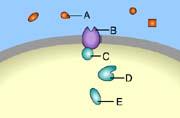
Which of these is a receptor molecule?
B
A signal transduction pathway is initiated when a _____ binds to a receptor.
signal molecule
Which of these is a signal molecule?
A
A signal molecule is also known as a(n) _____.
Ligand
Which of these is the second of the three stages of cell signaling?
transduction
Which of the following provides molecular evidence that signal transduction pathways evolved early in the history of life?
The molecular details of cell signaling are quite similar in organisms whose last common ancestor was a billion years ago.
Which of the following is a substance that acts at a long distance from the site at which it is secreted?
hormone
What is most likely to happen to an animal's target cells that lack receptors for local regulators?
They might not be able to multiply in response to growth factors from nearby cells.
In the formation of biofilms, such as those forming on unbrushed teeth, cell signaling serves which function?
aggregation of bacteria that can cause cavities
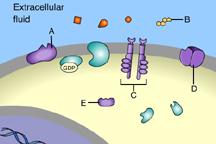
which one of these is NOT a membrane receptor?
E
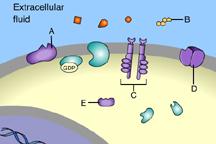
Which of these is a G-protein-linked receptor?
A
Which of these is a receptor tyrosine kinase?
C
Which of these is an ion-channel receptor?
D
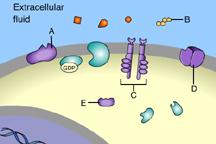
The binding of signal molecules to _____ results in the phosphorylation of tyrosines.
C
Which of these receptor molecules would allow Na+ to flow into the cell?
D
Which of these extracellular signal molecules could diffuse through a plasma membrane and bind to an intracellular receptor?
estrogen
A(n) _____ is an example of a signal molecule that can bind to an intracellular receptor and thereby cause a gene to be turned on or off.
steroid
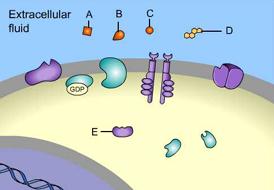
_____ is a signal molecule that binds to an intracellular receptor
D
Thyroid hormones bind to _____ receptors.
intracellular
To what does the term "ligand" refer in cell biology?
any small molecule that can bind in a specific manner to a larger one
Dioxin, produced as a by-product of various industrial chemical processes, is suspected of contributing to the development of cancer and birth defects in animals and humans. It apparently acts by entering cells by simple diffusion and binding to proteins in the cytoplasm, then altering the pattern of gene expression. Which of the following are likely to be the cytoplasmic proteins to which dioxin binds?
transcription factors
What is the function of tyrosine-kinase receptors?
enzymatic phosphorylation of tyrosine in the receptor protein
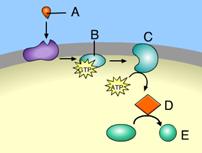
Which of these acts as a second messenger?
D
Which of the following are among the most common second messengers?
calcium ion and cAMP
Which of the following sequences is correct?
binding of a growth factor to its receptor → phosphorylation cascade → activation of transcription factor → transcription
binding of a signaling molecule to its receptor → G protein activation → adenylyl cyclase activation → cAMP production → protein phosphorylation
binding of a signaling molecule to its receptor → G protein activation → phospholipase C activation → IP3 production → increase in cytoplasmic calcium concentration
diffusion of a signaling molecule across the plasma membrane → binding of the signaling molecule to its receptor → movement of the signaling molecule-receptor complex into the nucleus → transcription
All of the choices are correct.
Which of the following could account for the different cellular responses to histamine? Select all that apply.
the cell type in which the histamine receptor is located
the type of second messengers involved in the signal transduction pathway
the enzyme that is activated by the G protein associated with the receptor
the types of relay molecules within the cell
Which of these is a logical signal transduction pathway?
A G-protein-linked receptor activates G protein, which activates phospholipase C, which cleaves a membrane lipid to form IP3, which binds to a calcium channel on the ER, which opens to release calcium ions into the cytoplasm, which bind to an intracellular enzyme that carries out a response.
What is apoptosis?
controlled cell suicide
Phosphorylation cascades involving a series of protein kinases are useful for cellular signal transduction because
they amplify the original signal manyfold.
Binding of a signaling molecule to which type of receptor leads directly to a change in the distribution of ions on opposite sides of the membrane?
ligand-gated ion channel
The activation of receptor tyrosine kinases is characterized by
dimerization and phosphorylation.
Lipid-soluble signaling molecules, such as testosterone, cross the membranes of all cells but affect only target cells because
intracellular receptors are present only in target cells.
Consider this pathway: epinephrine →\rightarrow G protein-coupled receptor →\rightarrow G protein →\rightarrow adenylyl cyclase →\rightarrow cAMP. Identify the second messenger.
cAMP
Apoptosis involves all but which of the following?
lysis of the cell
does involve: fragmentation of the DNA
digestion of cellular contents by scavenger cells
cell-signaling pathways
activation of cellular enzymes
Which observation suggested to Sutherland the involvement of a second messenger in epinephrine's effect on liver cells?
Glycogen breakdown was observed only when epinephrine was administered to intact cells.
Protein phosphorylation is commonly involved with all of the following except
activation of G protein-coupled receptors.
What are the functions of signal transduction pathways?
Signal transduction pathways amplify the effect of a signal molecule.
Signal transduction pathways convert a signal on a cell’s surface to a specific cellular response.
Signal transduction pathways allow different types of cells to respond differently to the same signal molecule.
Which statement correctly distinguishes the roles of protein kinases and protein phosphatases in signal transduction pathways?
Protein kinases activate enzymes by phosphorylating or adding phosphate groups to them. Protein phosphatases dephosphorylate or remove phosphate groups from enzymes, including protein kinases.
Select the statement that correctly distinguishes between relay proteins and second messengers in signal transduction pathways.
Signal transduction pathways are multistep pathways that include relay proteins and small, nonprotein, water-soluble molecules or ions called second messengers.
Cyclic GMP, or cGMP, acts as a signaling molecule whose effects include relaxation of smooth muscle cells in artery walls. In the penis, this signaling pathway and the resulting dilation of blood vessels leads to an erection. Select the correct statement about the effect of Viagra on this signaling pathway.
Viagra inhibits the hydrolysis of cGMP to GMP.
The cholera bacterium Vibrio cholerae produces an enzyme toxin that chemically modifies a G protein involved in regulating salt and water secretion in intestinal cells. Stuck in its active form, the modified G protein stimulates the production of a high concentration of cAMP, which causes the intestinal cells to secrete large amounts of salts into the intestines, with water following by osmosis. An infected person quickly develops profuse diarrhea and if left untreated can soon die from the loss of water and salts. What is the basic effect of the cholera toxin?
The basic effect of the cholera toxin is signal amplification.
Which of the following is true of steroid receptors?
The receptor may be inside the nucleus of a target cell.
Why are there often so many steps between the original signal event and the cell's response?
Each step in a cascade produces a large number of activated products, causing signal amplification as the cascade progresses.
Why can a signaling molecule cause different responses in different cells?
The transduction process is unique to each cell type; to respond to a signal, different cells require only a similar membrane receptor.
Transcription factors _____.
Control gene expression